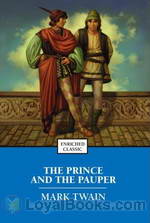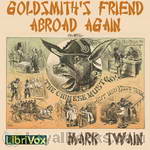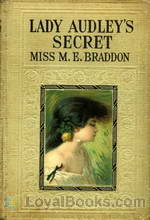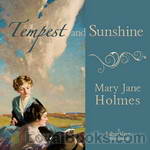|
Books Should Be Free Loyal Books Free Public Domain Audiobooks & eBook Downloads |
|
|
Books Should Be Free Loyal Books Free Public Domain Audiobooks & eBook Downloads |
|
Historical Fiction |
|---|
|
Book type:
Sort by:
View by:
|
By: Margaret Horton Potter (1881-1911) | |
|---|---|
 Castle of Twilight
Castle of Twilight
"Wistfully I deliver up to you my simple story, knowing that the first suggestion of “historical novel” will bring before you an image of dreary woodenness and unceasing carnage. Yet if you will have the graciousness but to unlock my castle door you will find within only two or three quiet folk who will distress you with no battles nor strange oaths. Even in the days of rival Princes and never-ending wars there dwelt still a few who took no part in the moil of life, but lived with gentle pleasures and unvoiced sorrows, somewhat as you and I; wherefore, I pray you, cross the moat... | |
By: Margaret S. Comrie (1851-?) | |
|---|---|
 Key to the Riddle
Key to the Riddle
Young Azerole Montoux and her brother Leon find themselves separated from their family by the religious persecutions of 1686. Threatened by the authorities and forced to depend on strangers, they must decide whether they can trust God to make sense out of the riddle of their lives. | |
By: Margaret Wilson (1882-1973) | |
|---|---|
 Able McLaughlins
Able McLaughlins
The Able McLaughlins won the Pulitzer Prize for a novel in 1924 in Margaret Wilson's debut work. Aptly described as "Little House on the Prairie - but for adults" the novel follows a group of Scottish families who pioneer the Iowa prairie in the 1860’s. The main storyline concerns Wully, the eldest McLaughlin son, who returns home from the Civil War to find that his sweetheart, Chirstie, has experienced an unspeakable tragedy that will profoundly affect the couple's lives. Their story is one of shame and honor, secrets and guilt, fear and loathing, revenge and forgiveness... | |
By: Maria Edgeworth (1768-1849) | |
|---|---|
 Castle Rackrent
Castle Rackrent
| |
By: Marjorie Bowen (1885-1952) | |
|---|---|
 Prince and Heretic
Prince and Heretic
This novel is centered on the Dutch House of Orange, and begins with its prince, William. It is set in the time of the Holy Inquisition, when tensions between the Catholic and Protestant churches dominated. | |
By: Mark Twain (1835-1910) | |
|---|---|
 The Prince and the Pauper
The Prince and the Pauper
A poor young boy from the slums of London watches a royal procession pass, with the youthful Prince of Wales riding at its head. He ventures too close and is caught and beaten by the Prince's guards. However, the young royal stops them and invites the vagrant to the palace. Here the two boys sup alone and are stunned to discover that they bear a startling resemblance to each other. The Prince is Edward, long awaited heir of the monarch, Henry VIII, while the vagrant is Tom Canty, the son of a thief and a beggar... | |
 Personal Recollections of Joan of Arc, Volumes 1 & 2
Personal Recollections of Joan of Arc, Volumes 1 & 2
Mark Twain’s work on Joan of Arc is titled in full “Personal Recollections of Joan of Arc, by the Sieur Louis de Conte.” De Conte is identified as Joan’s page and secretary. For those who’ve always wanted to “get behind” the Joan of Arc story and to better understand just what happened, Twain’s narrative makes the story personal and very accessible. The work is fictionally presented as a translation from the manuscript by Jean Francois Alden, or, in the words of the published book, “Freely Translated out of the Ancient French into Modern English from the Original Unpublished Manuscript in the National Archives of France... | |
 Goldsmith's Friend Abroad Again
Goldsmith's Friend Abroad Again
This satire on the U.S.A.'s myth of being the "Home of the Oppressed, where all men are free and equal", is unrelenting in its pursuit of justice through exposure. It draws a scathingly shameful portrait of how Chinese immigrants were treated in 19th century San Francisco. (Introduction by John Greenman) | |
 The American Claimant
The American Claimant
The American Claimant is an 1892 novel by American humorist and writer Mark Twain. The story focuses on the class differences and expectations of monarchic, hierarchical Britain and the upstart, "all men are created equal" America. Twain wrote the novel with the help of phonographic dictation, the first author (according to Twain himself) to do so. This was also (according to Twain) an attempt to write a book without mention of the weather, the first of its kind in fictitious literature. Indeed, all the weather is contained in an appendix, at the back of the book, which the reader is encouraged to turn to from time to time. | |
 How To Tell A Story, and Other Essays (Version 2)
How To Tell A Story, and Other Essays (Version 2)
The complete collection of works using this title. Other versions, including the Project Gutenberg version, have been radically shortened. Mark Twain published several collections of his short stories and essays. This collection, like the others, dramatically demonstrates the eclectic nature of his work and the depth of his humanistic thinking. Each essay stands alone. Listeners will find many instances where modern times come to mind. | |
 Death Disk
Death Disk
Mark Twain's "Death Disk" was inspired by the historical account of the execution of Colonel John Poyer of Pembroke, Wales on April 21, 1649. A small child was given the responsibility of selecting which of three rebel leaders of a civil uprising would receive a death penalty. The unfortunate fate was given to Poyer who was shot in front of a large crowd at Covent Garden. In 1883 Twain read about the child's role in the execution in a copy of Carlyle's Letters and Speeches of Oliver Cromwell, . In his personal notebook, Twain's imagination led him to remark, "By dramatic accident, it could have been his own child" ... | |
By: Marshall Saunders (1861-1947) | |
|---|---|
 'Tilda Jane
'Tilda Jane
When spunky 'Tilda Jane isn't allowed to keep her beloved dog with her at the orphanage, she decides to set out on her own in search of a home where the inseparable pair will be accepted. Throughout her weary travels she encounters many people, both rich and poor, kind and cantankerous -- but will she ever find family? Set in the Canadian wilderness and coast of Maine, 'Tilda Jane is a story of true grit, forgiveness, and unlikely friendship. | |
By: Martha Finley (1828-1909) | |
|---|---|
 Elsie's Children
Elsie's Children
This book continues the delightful "Elsie Dinsmore" series. Elsie's children, introduced in the previous volume, live life, grow up, and encounter various problems of their own. Additional Proof Listeners: AlaynaMay & Rachel. | |
By: Mary Brunton (1778-1818) | |
|---|---|
 Self-Control: A Novel
Self-Control: A Novel
The author: "This little tale was begun at first merely for my own amusement. It is published that I may reconcile my conscience to the time which it has employed, by making it in some degree useful. Let not the term so implied provoke a smile! If my book is read, its uses to the author are obvious. Nor is a work of fiction necessarily unprofitable to the readers." Jane Austen comments about this novel in a letter to her sister: “I am looking over Self Control again, & my opinion is confirmed of its’ being an excellently-meant, elegantly-written Work…” - Summary by Author and Jane Austen | |
By: Mary Cholmondeley (1859-1925) | |
|---|---|
 Diana Tempest
Diana Tempest
Colonel Tempest , his wastrel son Archie and beautiful daughter Diana are dismayed when they are cut out of the will of old Mr Tempest, Colonel Tempest’s brother. All of the Tempest fortune and estates at Overleigh pass to son John. However, everyone except John knows that he is illegitimate. Colonel Tempest, enraged, agrees in a drunken stupor to a bounty of £10,000 on John’s head although he later comes to bitterly regret this. Meanwhile, Di, who is strong and independent, has vowed she will never marry... | |
 Notwithstanding
Notwithstanding
The book starts with Annette Georges choosing between two fates: suicide and running away with a disreputable stranger. She is rescued by a kind woman who looks after her until she can go to live with her maiden aunts in a village in the English countryside. There she meets and makes friends with various people and, almost coincidentally, the facts of her past come back to play a crucial part in the story. - Summary by Simon Evers | |
By: Mary Elizabeth Braddon (1837-1915) | |
|---|---|
 Lady Audley's Secret
Lady Audley's Secret
Inspired by a true life story, Lady Audley's Secret is the story of a woman's overwhelming ambition and passion for social success. When the first book came out in 1862, Victorian readers were shocked and outraged by its portrayal of aspects like bigamy, insanity, yearning for social status and the will to commit murder to achieve one's goals. The novel belongs to a genre that became very popular during that era. Known as “sensation novels” they can probably be equated to today's pulp fiction... | |
 The Doctor's Wife
The Doctor's Wife
This is one of the Victorian “Sensationist” Mary Elizabeth Braddon's many novels (best known among them: “Lady Audley’s Secret”). It is extremely well written, fluid, humorous and, in places, self-mocking: one of the main characters is a Sensation Author. The motifs of the-woman-with-a-secret, adultery, and death are classic “sensationist” material. Yet this is also a self-consciously serious work of literature, taking on various social themes of the day. Specifically, Braddon presents... | |
 Sons of Fire
Sons of Fire
"He was a stranger in Matcham, a 'foreigner' as the villagers called such alien visitors. He had never been in the village before, knew nothing of its inhabitants or its surroundings, its customs, ways, local prejudices, produce, trade, scandals, hates, loves, subserviencies, gods, or devils , and yet henceforward he was to be closely allied with Matcham, for a certain bachelor uncle had lately died and left him a small estate within a mile of the village." | |
By: Mary Esther Miller MacGregor (1876-1961) | |
|---|---|
 Black-Bearded Barbarian
Black-Bearded Barbarian
A fictionalized biography of George Mackay (1844-1901), an influential Presbyterian missionary in northern Taiwan. | |
By: Mary Hallock Foote (1847-1938) | |
|---|---|
 In Exile and Other Stories
In Exile and Other Stories
Six short stories by Mary Hallock Foote (1847–1938), an American author and illustrator. She is best known for her illustrated short stories and novels portraying life in the mining communities of the turn-of-the-century American West. She is famous for her stories of place, in which she portrayed the rough, picturesque life she experienced and observed in the old West, especially that in the early mining towns. She wrote several novels, and illustrated stories and novels by other authors for various publishers... | |
By: Mary Jane Holmes (1828-1907) | |
|---|---|
 Tempest and Sunshine
Tempest and Sunshine
Tempest and Sunshine is the first book written by Mary Jane Holmes. Set in the pre-Civil War south, it follows the struggles and romances of two sisters, as different as night and day; blonde Fanny and dark haired Julia. (Introduction by jedopi) | |
 Rose Mather: A Tale
Rose Mather: A Tale
Fiction merges with history in this novel taking place during the turbulent times of the civil war and the horrors it entailed. Holme's silly, coquettish yet kind-hearted Rose will pull you in from the start. The sweet and pious Annie, the noble Tom Carleton, the motherly widow Mrs. Simms, the young and courageous Isaac, the mischievous rebel working for the south, and the brash, uneducated Bill Baker are just a few of the unforgettable characters who grow with every chapter. This is a tale of hardships and bravery, of fears and hopes, of inconsolable grief and love which will enthrall you to the end. - Summary by Celine Major | |
By: Mary Johnston (1870-1936) | |
|---|---|
 To Have And To Hold
To Have And To Hold
When I first started reading this book, I thought it to be a historical romance novel. As I read further, I pondered whether it might be a sea-faring story. Reading still further, I determined it to be an adventure story. Alas, it is all three. To Have And To Hold, written by Mary Johnston was the bestselling novel of 1900. The story takes place in colonial Jamestown during the 1600’s. Captain Ralph Percy, an English soldier turned Virginian explorer buys a wife - little knowing that she is the escaping ward of King James I... | |
By: Mary Raymond Shipman Andrews (1860-1936) | |
|---|---|
 Yellow Butterflies
Yellow Butterflies
The title of this historical fiction could as well have been "A Soldier’s Mother" or “An Unknown Soldier”. There are indeed butterflies, and there is a small boy who grows into a fine, strapping young man who goes to war. But this moving novella centers squarely on the young man's mother, her love for him and her abiding faith. | |
By: Mary Roberts Rinehart (1876-1958) | |
|---|---|
 The Amazing Interlude
The Amazing Interlude
It is the early days of The Great War. As the curtain rises, Sara Lee is sitting by the fire in her aunt and uncle’s home, knitting a baby afghan. Her beau’s name is Harvey. He has his eye on a little house that is just perfect for two and he will soon propose to Sara Lee. But in this play, the mise en scène is about to change. A fairyland transformation will take place and Sara Lee will step into a new and different story, where she is the princess in a forest of adventure. There is a prince, too, whose name is Henri... | |
 More Tish
More Tish
Mary Roberts Rinehart wrote 6 books about the elderly Letitia (Tish) Carberry and the escapades she gets her elderly lady cronies into. The series led to a 1942 movie with Marjorie Main. This particular book, the third in the series, was written after Mary's stint as a war correspondent in Belgium during the first World War. | |
By: Melville Davisson Post (1869-1930) | |
|---|---|
 Selected Uncle Abner Mysteries
Selected Uncle Abner Mysteries
Fourteen mysteries from the pages of the Saturday Evening Post, the Metropolitan, Red Book, and Pictorial Review magazines featuring Uncle Abner, who solves crimes in the pre-Civil War West Virginia hill country. His weapons are keen observation, logic, and a fundamentalist’s belief in the victory of good over evil. Post’s historical mysteries have been favorably compared to those of his fellow American Edgar Alan Poe. - Summary by Winston Tharp | |
By: Mór Jókai (1825-1904) | |
|---|---|
 Eyes Like the Sea
Eyes Like the Sea
He was a painter, a poet, a novelist. He lived during the Hungarian revolution and his love of freedom meant his life was often in peril. She was his first love, this girl with the eyes like the sea. She was at heart noble, good and loving. What an excellent lady might have been made out of this woman, if she had only met with a husband who, in the most ordinary acceptance of the word, had been a good fellow, as is really the case with about nine men out of every ten. But she always managed to draw the unlucky tenth out of the urn of destiny... | |
 Tales from Jókai
Tales from Jókai
Móric Jókay de Ásva, known as Mór Jókai or Maurus Jokai, was a Hungarian dramatist and novelist. He was a very prolific writer from an early age and wrote hundreds of novels, novellas, and short stories in his lifetime. The nine stories in this selection tell about hard times in Eastern Europe, especially in Hungary (Jokai was involved in the Hungarian uprising of 1848), as well as of ancient superstitions and folk lore. In the novella "The City of the Beast", Jokai gives his version of the sinking of Atlantis. | |
By: Myrtle Reed | |
|---|---|
 Old Rose and Silver
Old Rose and Silver
The novel follows the lives of Rose and her widowed Aunt, Madame Francesca Bernard, along with young visitor and cousin Isabel, whose lives are changed by the return of an old friend and neighbour Colonel Kent, and his grown son, Allison. Other characters that help shape their lives in significant ways are the Crosby twins, unconventional and uninhibited youths that set society at naught, and an unconventional doctor who specializes in the impossible. Through the limited "wide-scope" descriptions... | |
By: Nathan Gallizier (1866-1927) | |
|---|---|
 Under the Witches' Moon
Under the Witches' Moon
The scene is Rome, 935 A.D. Thirty-year-old Tristan, dressed as a pilgrim, overhears a conversation between Basil, the Grand Chamberlain, and Il Gobbo, his assistant. After the two have left, Tristan continues to observe the revelry on the Eve of St. John. Suddenly a chariot containing a beautiful woman stops before him. They exchange words. He kisses her hand. Then she moves on, leaving him to ponder her beauty as he returns to the inn where he is staying. That night he has an enchanting and haunting dream of him together with another woman... | |